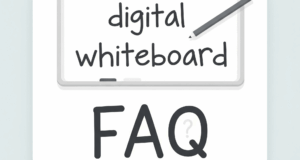How to Use Digital Whiteboards in a Classroom: A Comprehensive Guide
Digital whiteboards have revolutionized the way educators teach and students learn. These interactive tools offer a dynamic and engaging alternative to traditional blackboards or whiteboards. In this guide, we’ll explore the various ways to effectively use digital whiteboards in a classroom, from enhancing lesson delivery to fostering collaboration and creativity.
What Are Digital Whiteboards?
Digital whiteboards, also known as interactive whiteboards, are large interactive displays that connect to a computer and projector. They allow users to write, draw, and interact with digital content directly on the screen. Unlike traditional whiteboards, digital versions offer features like touch functionality, multimedia integration, and the ability to save and share work.
Benefits of Using Digital Whiteboards in the Classroom
Before diving into how to use them, let’s understand why digital whiteboards are a valuable addition to any classroom:
- Engagement: Interactive lessons capture students’ attention and make learning more enjoyable.
- Collaboration: Students can work together on the same board, fostering teamwork and problem-solving skills.
- Accessibility: Lessons can be saved and shared, benefiting absent students or those who need to review material.
- Multimedia Integration: Videos, images, and websites can be incorporated into lessons for a richer learning experience.
- Efficiency: Teachers can save time by organizing resources and reusing lesson plans.
How to Use Digital Whiteboards Effectively
1. Plan Interactive Lessons
Digital whiteboards are most effective when lessons are designed with interactivity in mind. For example:
- Use drag-and-drop activities for sorting exercises.
- Incorporate quizzes with instant feedback.
- Create interactive timelines or maps for history or geography lessons.
2. Encourage Student Participation
Allow students to take turns using the whiteboard. This can include:
- Solving math problems collaboratively.
- Presenting projects or research findings.
- Brainstorming ideas for group activities.
3. Integrate Multimedia Resources
Enhance lessons by embedding videos, images, and audio clips. For instance:
- Show educational videos directly on the board.
- Use interactive diagrams for science lessons.
- Play audio recordings for language classes.
4. Save and Share Work
One of the biggest advantages of digital whiteboards is the ability to save lessons. Teachers can:
- Export lessons as PDFs or images for future reference.
- Share work with students via email or learning management systems (LMS).
- Reuse templates for recurring lessons or activities.
5. Use Annotation Tools for Real-Time Feedback
Annotation tools allow teachers to provide immediate feedback on student work. For example:
- Highlight errors or key points during presentations.
- Add notes or comments to digital assignments.
- Use shapes and arrows to emphasize important information.
6. Foster Creativity with Drawing and Design Tools
Digital whiteboards often come with drawing tools that encourage creativity. Students can:
- Sketch diagrams or illustrations for projects.
- Design posters or infographics.
- Practice calligraphy or artistic techniques.
Tips for Maximizing Digital Whiteboard Use
- Train Yourself and Students: Familiarize yourself and your students with the whiteboard’s features to avoid technical hiccups.
- Keep It Organized: Use folders or categories to store lesson files for easy access.
- Balance Digital and Traditional Methods: While digital whiteboards are powerful, don’t rely solely on them. Mix in hands-on activities for a balanced learning experience.
- Regularly Update Software: Ensure the whiteboard’s software is up-to-date for optimal performance and access to new features.
Real-World Examples of Digital Whiteboard Use
Here are a few examples of how digital whiteboards can be applied across subjects:
- Math: Solve equations step-by-step with interactive graphs and charts.
- Science: Conduct virtual experiments or annotate diagrams of biological processes.
- Language Arts: Analyze literature with interactive text annotations or practice grammar exercises.
- History: Create interactive timelines or map historical events.
Conclusion
Digital whiteboards are a versatile tool that can transform the classroom experience. By planning interactive lessons, encouraging student participation, and leveraging multimedia resources, educators can create engaging and effective learning environments. With a bit of creativity and practice, digital whiteboards can become an indispensable part of your teaching toolkit.



